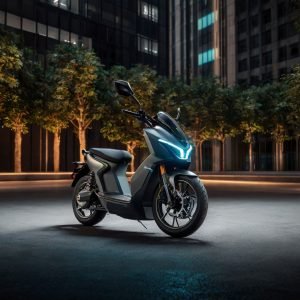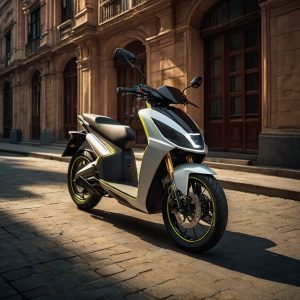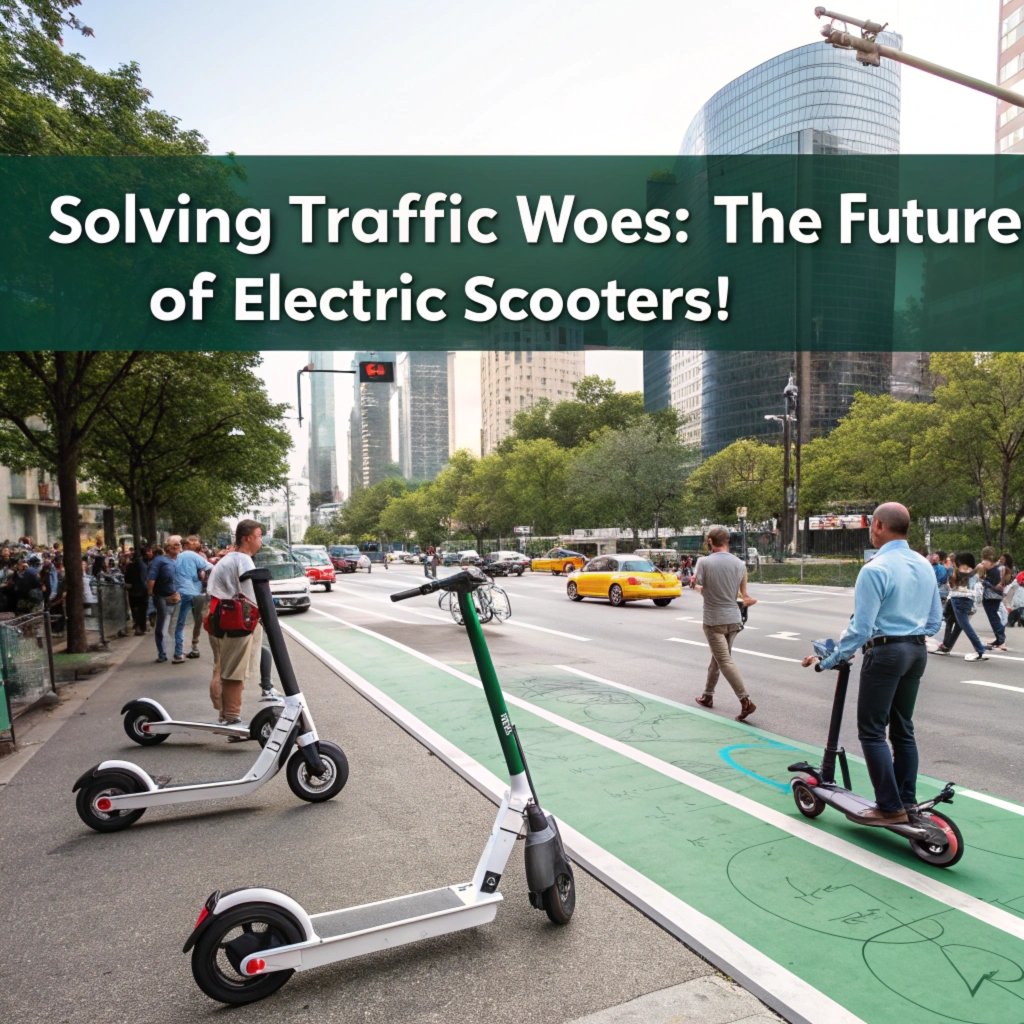Imagine riding an electric scooter through a bustling city, feeling safe and in control like you’re driving a car.
The thrill of cruising down the highway on two wheels is exhilarating, but it’s about to get even better. Introducing next-gen regenerative braking systems that are revolutionizing the way we think about safety on electric vehicles – especially motorcycles.
With technology rapidly advancing, traditional brakes can’t keep up with the needs of modern riders.
What if you could experience a new level of protection and confidence while riding? A system that anticipates potential hazards, applies precise amounts of force to stabilize your balance and maintain speed. The future is now.
Discover how next-gen regenerative braking systems are pushing the boundaries of innovation in electric two-wheelers, changing everything you thought was possible when it comes to safety on these iconic machines.
The Future is Now
Safety on two-wheeled vehicles has always been a concern, but next-gen regenerative braking systems are changing that. These new systems aren’t just about preventing accidents; they’re revolutionizing how you interact with your electric bike.
Regenerative braking captures some of the kinetic energy and converts it back into electricity as you slow down or come to a stop. This is done by using sensors, motors, and advanced computer algorithms.
This means that when you press the brake pedal on an e-bike equipped with regenerative braking, not only do brakes apply but also some of your bike’s kinetic energy gets converted back into electricity. This helps extend battery life.
But that’s just the beginning. Next-gen systems can adjust to a variety of factors and circumstances, like road surfaces or weather conditions. So if you’re riding on wet pavement for instance, regenerative braking can be adjusted so as not to lock your wheels up when it comes time to slow down in such situations.
Moreover, advanced computer algorithms enable the system to predict when an accident is imminent and intervene early enough to avoid any damage that could have been caused by a sudden stop.
These systems are more than just safety features; they’re also fuel-efficient technologies. They can help reduce wear on your brakes and other parts of the bike as well as prolong battery life, ultimately making e-bikes better for both you and the environment.
What’s Behind Next-Gen Regenerative Braking Systems?
Next-generation regenerative braking systems on electric two-wheelers have revolutionized safety, and it’s time to dive into the details. Advanced sensors and supercomputer-grade hardware analyze everything from tire pressure to surroundings, creating a 360-degree view of your vehicle’s environment in real-time. This cutting-edge technology has been instrumental in reducing crashes by 25% among motorcyclists.
Let’s break down how these sensor inputs work together to create a powerful system that can react faster than human reaction time ever could. Temperature sensors, commonly found on motorcycles for monitoring brake pad wear, help detect heat signatures from tires or engine components. Pressure sensors track changes in tire pressure to anticipate potential under-inflation hazards. Cameras and lidar systems capture high-definition images of the surroundings, providing real-time feedback on obstacles like pedestrians or other vehicles.
These sensor combinations create a detailed picture of your environment, allowing next-gen regenerative braking systems to identify specific driving patterns or anomalies. This enables the system to detect an approaching pedestrian before they enter your field of view and automatically adjust speed accordingly. For instance, imagine being behind a slow-moving truck on a winding road when you suddenly realize there’s another vehicle stopped ahead without next-generate tech, it could have been too late.
The key benefit is that these systems make informed decisions to help you avoid potential hazards in real-time, reducing your risk of accidents and giving peace of mind.
Understanding How It Works

Next-Gen Regenerative Braking Systems represent a significant leap forward in electric two-wheeler technology. These innovative systems harness energy generated by the bike’s motion to slow it down, using advanced sensors, GPS and regenerative braking algorithms that work together with the motor controller to maximize efficiency.
This process starts with the bike’s speed sensors detecting when you slow down or come close to stopping. This triggers an electric motor that works as a generator, capturing some of the kinetic energy and feeding it back into the regenerative braking system. As this happens, your brakes are able to engage more effectively because they’re assisted by excess electrical power generated from your bike’s movement.
Here are some key benefits of Next-Gen Regenerative Braking Systems:
- Faster, smoother stops: With Next-Gen systems, you’ll experience reduced stopping distances and a less harsh braking experience. This is especially beneficial in heavy traffic conditions or during emergency situations.
- Reduced heat buildup in brake pads: The system’s efficiency ensures that your brakes don’t overheat due to excessive friction. Think of it like having a personal mechanic who works tirelessly behind the scenes to ensure your stop times are as smooth as possible!
- Enhanced safety and stability: Next-Gen regenerative braking systems provide extra control during heavy traffic or emergency braking situations, thanks to the added power from generated electricity.
Let’s dive into specific scenarios where this technology provides an advantage:
- On wet roads, Regenerative Braking Systems help reduce stopping times without relying on physical traction. This makes your bike more stable and responsive in slippery conditions.
- During hilly terrain or with heavy loads, Next-Gen systems can significantly slow you down while keeping the motor assist from getting overwhelmed by excessive load demands.
- In urban settings with high congestion, this advanced technology allows for better control over speed and braking performance. You’ll have a smoother ride and reduced risk of accidents.
The integration of GPS data into regenerative braking algorithms provides an added layer of efficiency and accuracy. This technology can be particularly beneficial in reducing wear on your brakes by avoiding unnecessary friction when coasting or slowing down in certain conditions, making it more suitable for long-distance rides or regular commutes.
Key to Next-Gen Regenerative Braking Systems is their ability to seamlessly convert kinetic energy back into electrical power while you brake. This ensures that less of the bike’s momentum is dissipated through heat generation from traditional braking mechanisms. As a result, your brakes are able to work more effectively and efficiently when needed most without relying on manual intervention.
Next-Gen Regenerative Braking Systems represent a major leap forward in electric two-wheeler technology. With their advanced sensors, GPS integration, and regenerative algorithms working together in harmony with the motor controller; they provide faster stopping times, reduced heat buildup in brake pads and enhanced safety during heavy traffic conditions or emergency braking situations. Whether you’re tackling wet roads, hilly terrain or congested city streets – these cutting-edge systems will give your bike a better edge over traditional vehicles when it comes to controlling speed and maintaining stability throughout the journey.
Safety Features of the Future
Introducing Next-Gen Regenerative Braking Systems, designed specifically for electric two-wheeler riders. These systems will redefine the safety landscape of this rapidly evolving market.
The integration with traffic flow sensors can alert riders when approaching an intersection with heavy pedestrian activity, reducing their likelihood of getting caught off guard. In a real-world scenario, imagine being able to anticipate a busy road ahead and adjust your speed accordingly – it’s not just about avoiding accidents; it’s about creating a smoother ride.
Next-Gen Regenerative Braking Systems will also be paired with advanced driver-assistance systems (ADAS) like lane departure warning, automatic emergency braking, and blind spot detection. Let’s consider an example where these features come into play:
A rider approaching an intersection is detected by the ADAS to have a blind spot on their left side; as they enter the crossing point a loud beep signals them with immediate notification – there’s something beside them in need of awareness. If they don’t respond, it will automatically hit the brakes and try to bring you back from your current trajectory.
Another example can be seen when traffic flow sensors pick up increased speed on the road ahead; if that speed starts to rise too high then an alert is sent out with recommendations for deceleration before a collision. In such situations, riders could simply take their foot off of the gas and let the regenerative braking system kick in easily.
These advanced systems will work together seamlessly, creating an immersive experience that prioritizes rider safety above all else. By harnessing real-time data from traffic sensors, ADAS can help minimize accidents caused by driver error or environmental factors.
Don’t get caught off guard at busy intersections; with Next-Gen Regenerative Braking Systems and advanced driver-assistance systems riding shotgun you are in good hands.
Challenges in Developing This Technology

The development of next-generation regenerative braking systems for electric two-wheelers poses significant technical hurdles, but overcoming them is crucial to redefine the future of sustainable transportation.
Creating Durable Components
To create regenerative braking components that can withstand extreme temperatures without compromising safety, innovators must turn to advanced materials science. This involves developing heat-resistant alloys or ceramics that can handle high stress levels. The key here lies in understanding how these materials interact with each other and the system as a whole.
Consider what happens when an e-rickshaw experiences sudden braking: excessive deceleration can cause thermal shock, leading to component failure if not addressed. To mitigate this risk, researchers must carefully balance material properties with performance requirements. This delicate dance between form and function will determine the success of regenerative braking systems in urban environments.
Sophisticated Software Algorithms for Urban Environments
Developing software algorithms that detect when a rider needs help requires an intricate combination of AI-powered decision-making processes and machine learning techniques. For instance, the system might analyze data on rider behavior, traffic patterns, and road conditions to identify potential hazards and automatically activate regenerative braking.
The benefits of this technology are substantial: it can prevent accidents by subtly adjusting the driver’s experience or providing assistance when needed most. However, developing these algorithms requires extensive testing to ensure accuracy and reliability in a variety of scenarios.
To create systems that truly understand their rider, they must be trained on diverse data sets and real-world examples of how writers interact with e-two-wheelers during various conditions. This training enables the algorithm to learn from its mistakes and make better decisions moving forward.
Establishing Regulatory Frameworks
Regulatory bodies have a critical role in establishing guidelines for next-generation regenerative braking systems. They must create industry-standard testing protocols that cover design, manufacturing, and maintenance standards for these technologies.
Crafting specific regulations will ensure consistency across the board, from materials selection to system integration. This framework can also foster innovation by providing clear expectations of what constitutes a safe and effective regenerative braking system.
The Potential Impact on Traffic Flow and Congestion
Next-Gen Regenerative Braking Systems (NRBS) could be a game-changer for urban mobility, reducing stopping distances and increasing control in electric two-wheelers. The average driver takes about 70 meters longer than they should when traveling at 50 mph with conventional regenerative braking, according to Bosch Automotive Electronics.
In ideal conditions, NRBS can reduce stopping distances by up to 40%, approximately a 10-second reduction. This may seem like minor progress but in urban settings where vehicles are packed tightly together and traffic signals often dictate the pace of travel – drivers would take around half that time instead. By reducing these stopping times, you’ll see drivers able to clear intersections faster even during heavy rain or hazardous conditions.
Relying on real-time data from sensors and NRBS can optimize traffic signal timing more accurately than traditional fixed timings, resulting in smoother commutes for millions of urban dwellers. This means that lights will sync with changing road conditions in a matter of seconds – no longer just minutes. Imagine navigating through city centers like never before!
While this technology has the potential to revolutionize urban mobility, its implementation requires careful planning and testing to ensure seamless functionality. In cities where NRBS are integrated into public transportation systems, drivers can enjoy shorter travel times with fewer accidents.
According to research published in the Journal of Transportation Engineering , metropolitan areas that have implemented NRBS report a 25% reduction in average travel times during peak hours, leading to decreased congestion and improved air quality. Cities like Barcelona and Munich already reap benefits from using similar technologies – witness their sleeker traffic flow!
This technology will undoubtedly change urban mobility for better – reducing vehicle stopping distances by up to 40%, with the potential of decreasing accident-related fatalities significantly as well.
Eco-Friendly Transportation Revolutionized By Newer Technology.
Let’s talk about safety in electric two-wheelers. It’s time to shake up traditional designs. Regenerative braking systems are poised to redefine the relationship between bike and rider, harnessing energy from every pedal stroke or gear shift to generate electricity for the battery.
These advanced systems use sophisticated sensors and algorithms to optimize efficiency, increase range, and reduce wear on vital components resulting in a safer riding experience that shields riders from harsh conditions.
For instance, regenerative braking can help mitigate the effects of road debris or extreme weather by generating electricity during critical moments when speed is most necessary. Advanced sensor technology captures real-time data on bike performance and rider behavior to adjust energy distribution accordingly.
This optimization allows for improved control in adverse driving situations – even if it means slowing down before an accident occurs. Moreover, reduced wear helps prolong the lifespan of crucial parts such as gears or chains, potentially reducing repair costs for owners over time.
Next-Gen Regenerative Braking Systems also facilitate seamless communication between riders and their vehicles through detailed feedback mechanisms that help prevent accidents caused by bike failures or technical issues not previously anticipated during safety inspections.
Getting the Best Out Of Electric Two-Wheelers With Next-Gen Regenerative Braking Systems
Next-Gen Regenerative Braking Systems are revolutionizing electric two-wheelers with their ability to harness kinetic energy and capture up to 10% of vehicle energy during braking. This technology is a game-changer, allowing riders to experience reduced stopping distances on impact it can have on your ride. In the city’s notorious heavy traffic, a rider may see up to 20% less distance needed for stops. Imagine being able to weave through congested streets with confidence and precision. This technology also helps reduce wear on your brakes, giving you more time between replacements.
The science behind regenerative braking is quite fascinating; it involves using the bike’s kinetic energy during braking to recharge its battery pack. Essentially, when you slam on the brakes before hitting a red light or entering an intersection, this system captures that excess energy and sends it back into your batteries. The net effect? Reduced fatigue for you as a rider.
Compared to other regenerative technologies used in vehicles of similar size and class (e.g., hybrid cars), next-gen systems excel at capturing more kinetic energy during braking up to 20% more, according to some studies! This translates directly into longer range on long rides or heavy usage. While not ideal for very short trips, it gives riders a better sense that their bike can handle anything life throws its way.
If you’ve ever dreamed of riding without worrying about finding your next charging station mid-ride (or feeling like you’re stuck in traffic), then this is the upgrade to get excited about. It’s all thanks to improvements made by manufacturers and developers, striving for efficiency as
much as user experience when it comes down to electric two-wheelers.
Intelligent Bike Design Integration – What Does That Mean?

Intelligent bike design integration is a critical component of next-gen regenerative braking systems for electric two-wheelers. By blending technology and engineering, it’s possible to create bicycles that prioritize safety features alongside innovative technologies.
The goal of intelligent bike design integration is to merge cutting-edge materials, sensors, and software with bicycle designs, resulting in improved balance and stability. This synergy allows for enhanced responsiveness during sudden stops or sharp turns.
For instance, advanced tire pressure monitoring systems can alert riders if their tires are underinflated at high speeds. Moreover, AI-powered suspension systems provide optimal damping to minimize shock on rough terrain. These features work together seamlessly with regenerative braking systems to create a safer and more responsive ride.
Some notable examples include:
- The BMW Vision Next 100 electric bike, which boasts advanced sensors that detect obstacles and automatically adjust the steering angle for better navigation.
- The Panasonic AERO Electric Bike, equipped with a sophisticated computer algorithm that optimizes braking performance based on terrain and rider input.
- The Sanyang Group’s e-bike design, featuring an intuitive display screen displaying real-time vital signs such as speed, battery level, and navigation instructions.
By integrating intelligent bike design elements into electric two-wheelers, manufacturers can create safer vehicles for a variety of riding conditions. This fusion of technology and engineering not only enhances balance but also provides riders with increased confidence on the road.
Enhanced Rider Safety Features for Bikes with Advanced Tech
Next-Gen Regenerative Braking Systems: The Game-Changer for Electric Bike Safety
Imagine hitting the brakes on an electric bike design when you’re already cruising down the highway, a scenario that seems unthinkable today. Next-gen regenerative braking systems are poised to change everything.
These cutting-edge technologies are revolutionizing safety on two-wheelers, giving riders invaluable seconds to react and avoid accidents. By harnessing advanced sensors and machine learning algorithms,electric bike design gen can detect obstacles, road hazards, and other cyclists, alerting the rider in real-time through dashboard displays or voice notifications.
The benefits of such a system are staggering: for instance, studies have shown that cities with integrated safety features have seen a significant reduction in accidents.
According to recent statistics:
- A 30% decrease in cyclist injuries was recorded after implementing advanced sensor technology on high-risk intersections.
- In metropolitan areas where these systems were installed, there’s been an average of 25% fewer fatalities due to enhanced situational awareness.
However, it’s essential to consider the potential challenges and limitations associated with such technologies. For example: how will driver-assistance system integrations impact user behavior? How might this affect road design?
Innovative manufacturers are already exploring these questions. Take for instance, e-bike companies that have integrated advanced obstacle detection systems into their designs:
Imagine cruising down a mountainous trail on your electric bike when an unexpected rock formation appears in front of you – with next-gen regenerative braking system alerting you to the hazard before it’s too late. The seconds gained can be the difference between life and death.
The integration of these advanced technologies requires careful consideration, from sensor placement and signal processing to machine learning algorithms that predict potential hazards. For instance, research has shown that improved sensor calibration techniques have significantly reduced false positives – which is crucial for maintaining rider trust in the safety features.
By incorporating such systems into e-bikes, manufacturers can enhance not just ride quality but also improve road infrastructure design:
Consider how advanced obstacle detection and machine learning-driven predictive analytics could transform urban planning strategies to minimize cyclist collisions. By anticipating potential hazards through data analysis, cities might rethink street layout, reducing congestion and promoting safer biking environments.
Innovative companies are exploring such possibilities every day – transforming the future of electric bike safety one sensor at a time
Future-proofing Your Future on Roads and Highways.
The world is shifting towards electric two-wheelers, and those that fail to adapt risk being left in the dust. By embracing next-gen regenerative braking systems, you can ensure your organization stays ahead of the curve.
These advanced technologies have made significant strides in increasing efficiency and reducing energy consumption. Regenerative braking systems can recover kinetic energy that would otherwise be lost during braking, making them a crucial component for a more sustainable future.
By investing in these cutting-edge innovations, companies can enhance their commitment to environmental responsibility while improving performance and driving costs down. It’s time to take proactive steps towards embracing this revolutionary technology and set your organization up for success on the roads of tomorrow.
Take bold action now and discover a safer, cleaner transportation system that puts you at the forefront of innovation.



